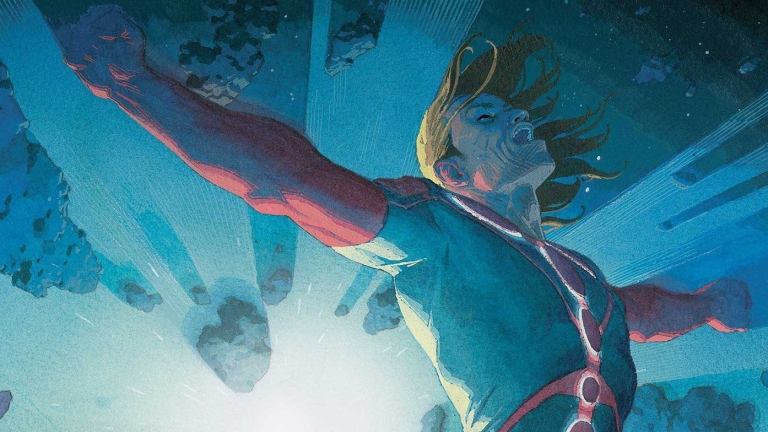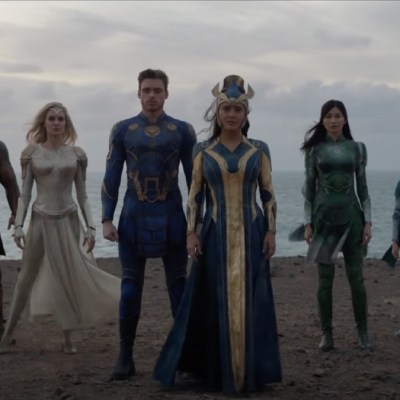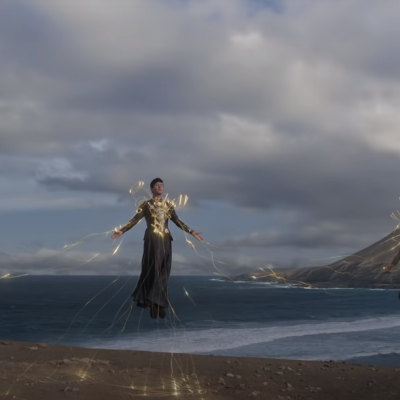The Secrets of Marvel’s Eternals
Kieron Gillen talks to us about his work on Marvel's Eternals.

This article contains Eternals spoilers.
It’s not hard, when a Captain America or an Iron Man movie hits, for Marvel to have a comic on shelves that new fans can be pointed toward as an accessible way to get to know the characters. The same can’t be said for The Eternals. In a lot of ways, Jack Kirby’s most bizarre creations – god-like beings, created by the all-powerful Celestials to do battle with the deformed, wild Deviants – have endured despite their relative scarcity. The sum total of what can be reasonably called Eternals stories only runs to about 50 issues. So the task of centering them ahead of their big movie debut in November is both a blessing and a curse, even with an all-star cast and an Oscar-winning director at the helm.
Enter Kieron Gillen.
Gillen is a Marvel veteran and no stranger to the company’s cultural juggernaut side. Counted among his greatest hits are a long run with Kid Loki in Journey into Mystery, a thematic touchstone for the MCU’s biggest television show to date. And he authored what is likely going to be an important comic to the MCU going forward in Young Avengers. When he’s not creating the source material for potential future blockbusters, Gillen is fairly skilled at playing with mythology: his creator-owned book for Image Comics, The Wicked + The Divine (co-created with his Young Avengers collaborators, Jamie McKelvie and Matt Wilson) mashed-up pantheons from around the world with pop music culture, and was a smash success. So Gillen was a natural choice to set on the weirdness of Eternals.
For this new series, Gillen finds himself teamed with a pack of superstars on his Eternals relaunch – Esad Ribic, one of the most talented and epic line artists who’s ever worked in comics; Eisner winner Wilson on colors; and beloved star letterer Clayton Cowles lettering and doing the data page design work. We had a chance to chat with Gillen about his approach to the concept and what he’s got coming next.
Den of Geek: Late period Kirby stuff is pretty dense and odd, and generally tough to follow up on. I know Eternals is something that’s only spottily been touched through the course of Marvel history since he did it and usually to great effect. What was your first principle coming into this to make sure that you weren’t flattening the Eternals concept into just another superhero book, and at the same time, keeping it friendly to new readers who might have had limited exposure?
Kieron Gillen: My actual approach is very much the opposite, in terms of trying to flatten it into a cape book, because I think when they flatten into a cape book, they lose any point of existing. The Marvel Universe is such a busy place…a lot of the niches are filled.It’s like, if you were at DC, you couldn’t, for example, make a new hero, who is the paragon of all that’s good and everyone in America really likes him, because that’s Superman’s job. In any of these highly populated universes, you’ve got to look at, “Okay, how can I make them different? How can I find something that’s really just them?” So my approach is much more into drilling down to what makes them weird, what makes them different for audiences. And also things that have been implicit in the concept, I can perhaps put a spin on and make it even moreso.
One of the core things originally that I looked at is how when Kirby originally created Eternals, it wasn’t really for the Marvel Universe. They were folded in, and the work done by generations of creators there has been really interesting. But they sit differently in a universe where there’s actually gods, because their entire thing was they are people who have been mistaken for gods, and were actually aliens. There’s very much riffing on the 1970s Chariot of the Gods-ness of it all. Except of course, if you’ve got a universe where you’ve actually got gods, that starts to fray at the edges.
So what was a niche in the Marvel Universe that isn’t filled by the gods? I ended up with the idea that, if you actually look at it, even in the original Kirby stories, they’re people who’ve been mistaken for gods. In reality, they are a species of eternal unchanging immortal beings who have been created by actual space gods (the Celestials that are the gods in this metaphor) in eternal battle with these demon-like creatures [Deviants].
I picked up some of the stuff that Neil Gaiman added to the concept, in terms of their immortality. Eternal is a very different word. You talk to certain theologians, there’s a debate whether angels have free will. Humans probably do. I’m not a theologian so don’t trust me on this, but the idea of whether angels have free will is a much more interesting question in lots of different ways. So I leaned into the idea that Eternals are angels. They’ve got this job and their job is to protect us, or at least the Earth, from demons. I pushed them into those elements, so all that stuff is very much let’s make them more weird.
My broad theory is with DC characters the problem is the world. They are beautiful and perfect people who are facing a world that is corrupt. So Batman’s life is fine and then his parents were killed. Wonder Woman is sent as an ambassador to this warlike species of man. I think Wonder Woman is an interesting one to compare to because the closest Marvel character is really Thor. Thor is somebody who was sent to Earth because he was an arrogant shit [laughs]. To save the world, yes, but he is also the problem. So for me, the heart of Marvel characters, even though they try to save the world, they’re also the problem.
And for me, the Eternals didn’t really have that, and that’s why I’ve led to this idea that there’s this awful secret that when they die, they have to take a life to carry on living. And that’s, at least, one reason why Ikaris had to be my lead. Because Ikaris is such a good guy and the idea of, “Wait, when I do stuff, it’s not just my life I’m risking.” I know it’s not something [he’s] going to move past easily. He’s clearly going to be guilty, dealing with this for a very long time and there’s the relationship with the family and all that kind of element. And that seemed to be really interesting, especially because, and this goes into other areas with more Eternals, is that I always wanted them to be a society.
A lot of the Eternals don’t care. They’re ambivalent about this and in some ways they’re the bad gods. The idea of the Eternals includes people with very different ideas and yes, their job is to protect the Earth, but that doesn’t necessarily mean protecting humans.
I’m fascinated by the comparison to angels because where they’re left at the end of issue six is very much a Paradise Lost situation where, not only are they fallen, but they’ve decided to cast themselves down. That brings Thanos in conceptually too. What was the most mentally complicated part to integrating Thanos into this new Eternals mythology for you? Because he’s more an external force of nature in the broader history of the Marvel Universe than he is really tightly aligned with Eternals history. But now with the Deviant stuff and the fallen Eternals, he feels much more integral to the concept than he used to.
When you think about Eternals, we’ve got the original Kirby stuff and then the generations of creators that have tried to integrate them in different ways into the Marvel Universe. It’s notable that some of the best stuff in Eternals has become everyone’s stuff, like the Celestials. But the Celestials are such a great fit. They’re one of the best visuals in all of Marvel. So many different people have touched on this connection between the Eternals and Thanos, [but] not much has ever really been done with it.
One of the aims for Eternals was to take continuity and turn it into mythology. So I was looking at all that 40 years of comics and trying to work out okay, let’s pretend they were all made by one person and it was all one big fabric. The creation of Thanos in my mind was always planned all along, and this is a fundamental sin of the Eternal people. It wasn’t that they had a kid who turned out bad. Kirby’s original idea was 100 Eternals, 100 Deviants, then only the Deviants breed.
So there’s only ever been 100 in this weird static family unit, but what happened with Titan? What were all the schisms for? Where did Thanos come from? Thanos was really an attempt to extend the Eternal line, which went very badly wrong. You mentioned Paradise Lost, but I just got the Titanos Schism, which is an event in the history anyway, but I built up to being the equivalent of, I don’t know, one of those stories in Lord of the Rings, set 500 years earlier that’s in the appendix.
This is actually some of the stuff we cover in [The Eternals: Thanos Rising,] the Dustin Weaver special we’re doing. We talk about the background of all this. They argued whether they should actually have true Eternal children. They split. A’Lars AKA Mentor, met up with Sui-San on Titan. They work out a way to have Thanos (which is what the special is about) and hooray, they can breed. And then “oh no, this is what happens when we breed.” Thanos is really the worst case scenario.
But the other interesting thing is, of course, Thanos gets to meet his other family. The idea there’s a whole extended family he’s interacted with very little, which is really interesting to me. In the first arc, I’ve written him as Frankenstein or the Phantom of the Opera. He’s just the Alien. He doesn’t know what to do. He’s regarded as a force of nature.
I do this a lot in my books. People always say, I don’t really like villains. As much as I enjoy Thanos chewing the scenery and talking about poetry and death, I write them as people with powerful needs. The question becomes what will they do to get them? The answer, of course, [for] people like Thanos, is almost everything. But what’s always interesting for me is what won’t they do as well? If you can emotionally connect to all the characters, even the ones you hate, even the ones you want to lose, that’s when stuff becomes interesting for me.
Which Eternal was your hook when you first started thinking about the book? Who was your path into the world and did it change as you went deeper into it? Who do you hope readers attach to from your story as they head to theaters to see the movie?
Originally Ikaris and Sprite were the two, and I made them the point of view characters for two reasons. One, Ikaris is the most straight shooting character, therefore he was the person who would most be hurt by the twist. He’s the classic hero, so let’s put him through the grinder. And Sprite, of course, had been outside the story, so she’s useful because she doesn’t know stuff.
I’ve got a version of Sersi who is a kind of depressed party girl. She’s been an amazing party girl figure. She’s always been enormous fun and I love that. I just wanted to do the alone on the dance floor kind of vibe, where there’s a certain sadness because she’d been doing hedonism for so long, what’s it covering up. Sersi around Eternals is a little bit different from her around humans. I think Sersi is, in some ways, the most complicated and messiest of the characters. I hope she’s the one I think we’re most attached to.
It’s a very different take on Gilgamesh. My biggest regret of the first arc is I couldn’t find space to use Makkari or Ajak, so I’m very glad that I got to do the specials.
That’s kind of what Kirby did. One of the interesting things about Eternals in the original run is that it’s cut off early while he’s still introducing stuff. It’s not like it reached the midpoint. You’ve still got new characters coming in. All the way through he’ll throw a random issue in with a different Eternal. It’s very free flowing.
There’s nobody in comics right now that does grand spectacle like Esad and Matt together. Did having them attached on art change how you approached the scale of the story?
I must admit I think I knew Esad was on the book before I started writing anything seriously. So leisurely it was, you know those amazing deep focus panels Esad does when you’ve got a city and something in the distance. I always think about that bit in Thor with Jason [Aaron], where you have the enormous dead giant in the background [note: Thor: God of Thunder (2012) #3 page 9]. I remember that and the moment, oh no, no, we’re going to have a lot of deep focus shots. I’m always looking for chances to do that with Esad because why wouldn’t you? [laughs] Obviously, I know Matt really well, having gone through all manner of growing with him, so I know how adaptable and how amazingly he responds to different characters, or different artists rather.
His colors for Dustin Weaver are really amazing in the Thanos Rising special. The fact it’s a story set earlier in the timeline he’s doing a modern take on old ‘70s coloring. It’s really psychedelic and pop, but the whole thing is clearly a modern comic, but at the same time, clearly lifting notes. But with Esad, it’s always how can I do something that allows Esad to actually provide the scale of things? Because it’s a very chatty book, but I’ve got to find interesting ways to make things chatty, interesting things. It doesn’t just have to be a battle scene. Even just an establishing shot is a thing of beauty.
There’s these six Eternal cities I’ve codified. And the idea of, okay, when we go to those cities, it’s going to be the magical moments. In the same way, when we introduce New York in the first issue, that’s also a magical moment because it’s New York. In many ways, especially to a British person, New York is as magical a city as Olympia. There’s that kind of thrill.
Do the data pages help you get out of your own way or get out of Esad’s way on the art a little bit more?
A little bit. They’re a useful compression device.. At least part of the appeal of Eternals is its scope. Esad makes it really big visually, also big in the ideas of what we’re describing. There’s entire cast members and there’s political systems and there’s those groups who hate each other or like each other and I’m bearing all that in mind when writing it. And the data pages are a really good way of doing it.
Jonathan Hickman’s been doing it forever. I remember. When his Nightly News dropped, it was fascinating, but I’ve been really glad he’s managed to open up a bit of space in the mainstream for people to do that. Because it’s the thing I said I want to be a bit careful around this. I said, I always use a lot of text stuff in my indie work and there’s bits of all manner of text stuff I did before. I think it’s much more notable with Jon because Jon’s the designer so he can just do his own. With me, it was always a case of my interest in text and image and things you can do with that were limited by the fact that the resource I could have.
But what I was trying to is not just do what the X-books have done as well. [This] is the first time [Clayton Crain]’s done design internally and he’s doing amazing work, but it’s also stuff like the spread in issue three where we’ve got all those names. I literally programmed my own Deviant name generator. This generated 1,200 names on that page that Clayton laid out. We’re still working out how we’re going to release that online.
What are you most excited for people to see in the second arc of the book?
The first arc’s been all about remaking the Eternals, as in here we are, we’ve got a new status quo, more heroes are dealing with the fact that there is a corruption at the heart of their system. Can they change it? Can we change this unchanging system? That’s the tragedy of their heroism to me.
The second arc, I’m trying to do that to the Deviants. Not as radically because I don’t think the Deviants need it as much. What are the Deviants for? What are they like? If the Deviants were our lead characters, we would be absolutely petrified of the Eternals and now they’re living here. So we get to really meet the Deviants, we get to understand their life and their tragedy.
There’s an enormous battle. That’s something to look forward to. There’s romance and sadness, and there’s also really cool guest stars in the background, which I don’t want to talk about, but it’s important for me to ground this in the Marvel Universe. But also this is a world of humans. It’s not just weird Eternals falling around their fortresses. If an issue doesn’t have humans in it, I feel a bit off because for me that’s another thing about Marvel. Part of the fun of Spider-Man was always that I could look to my left and imagine Spider-Man flying past me, so trying to keep the element, the world outside your window, while still doing something with the scale of what we’re doing, that’s the trick. So I’m hoping that comes across in the next arc.
Eternals: Thanos Rises #1 is on sale on Wednesday, September 15th in local comics shops and online. Eternals: Celestia, the story featuring Makkari and Ajak, hits shops and the web in October, and Marvel’s Eternals is in theaters the following month.


